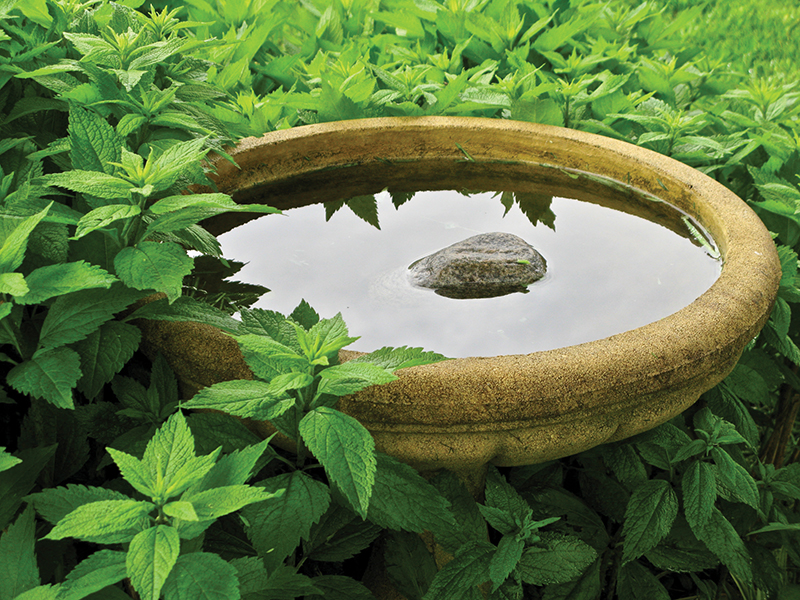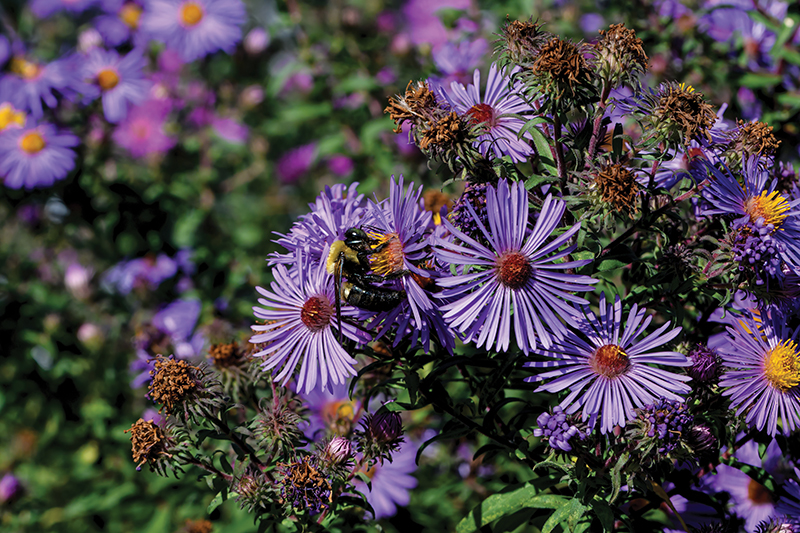

Bumblebee on New England Aster in the garden. Image Credit: Getty Images/McKinneMike.
The headlines are discouraging: A 69% average decline of birds, amphibians, mammals, fish, and reptiles since 1970.* Insects, too, are known to be experiencing a “multicontinental crisis” with dramatic reductions in their abundance. These declines in nature—referenced by author Michael McCarthy as the “great thinning”—represent not only the loss of essential services that we rely on (such as pollination that provides us with many fruits, vegetables, and nuts) but also the solace that we increasingly seek from the experience of nature.
If you’re looking for a way to be part of the solution to the state of the planet, look to your home landscape: there is plenty of opportunity right in your backyard.
Our yards and gardens, in addition to parks, open spaces, and other unmanaged areas, maybe even that unruly “hell strip” next to the road, comprise a lot of territory, and can collectively provide habitat for all manner of species. They can also link yards, neighborhoods and communities to provide important—even essential—pathways for nature to adapt to climate change.
Inviting wildlife into our yards through our gardens creates a “positive feedback loop” that includes gratification, pride, and the incentive to continue. In addition to the pleasure of seeing wildlife at home in our yards and community spaces, wildlife also helps our local forests and natural communities. Seeds that are consumed, buried, or stockpiled play a key role in ensuring the continuation of many plants. A recent study conducted by Yale University noted the key role that animals play in recovering tree species by carrying a wide variety of seeds into previously deforested areas.
Inviting birds into one’s backyard has been a growing pastime for many years. In the United States alone, the US Fish and Wildlife Service reported in 2011 that over 45 million people enjoyed watching birds around their homes and on trips. And although suburban backyards more often attract generalist species, they provide the type of experience for those observing that increases both interest in and support for conservation action.

Providing water is essential, especially during dry spells, for birds, small mammals, and even insects. Keeping the basin clean by replacing the water frequently helps avoid unwanted mosquitos and helps avoid spreading disease. Image Credit: Judy Preston
Insects play an important role in supporting birds, especially during the breeding season. One should consider “leaving the leaves” in the fall as mulch for overwintering insects, or allowing some of those perennial plants to remain standing over the winter to provide safe haven for the spring caterpillar supply to feed nestlings.
Native vegetation—plants that have co-evolved with the animals that interact with them—have been linked to increases in birds, bees, and other wildlife that are adapted to the resources that these plants provide. This time-honored coupling becomes more essential as time and climate vicissitudes stress native wildlife.
A study done in 2016 in Springfield, Massachusetts, looked at the capacity of suburban lawns (free of pesticides) to support bees. In one summer, just seventeen square yards generated over 5,300 individual bees (most of them native solitary ground-nesters), representing 111 species—nearly 30% of the bees known in the state. Left under-managed, these lawns also provided over 60 plant species (most not intentionally planted), suggesting that lawns can provide important resources to support pollinators. Judicious use of herbicides, pesticides, and fertilizer can make lawns environmentally friendly.
A 2021 paper published by the Ecological Society of America looked at the role of residential yard management and landscape cover effects on urban bird diversity across the United States. Observations such as minimizing impervious surfaces—the amount of ground covered by patios, walkways, and driveways, and increasing tree canopy were important strategies to conserve important bird species. Intensely maintained lawns tended to host more common, general bird species, such as house sparrows and robins; less common birds with specific habitat needs were found in yards certified as “wildlife habitat.”
Home landscapes that offer a diversity of native vegetation in varied forms promote wildlife habitat; even better if they also offer water and seasonal nesting resources with judicial use of pesticides. (Examples of effective native vegetation include trees, shrubs, and low-growing herbaceous ground cover such as wild geranium.)
To sum it up, there is no downside to adopting even modest ways to share your home landscape with other species, but lots of upside.
The next Gardening for Good article will provide suggestions for low maintenance, habitat friendly shrubs, just in time for the best season—the fall—to plant them.
Judy Preston is a local ecologist active in the Connecticut River Estuary.

